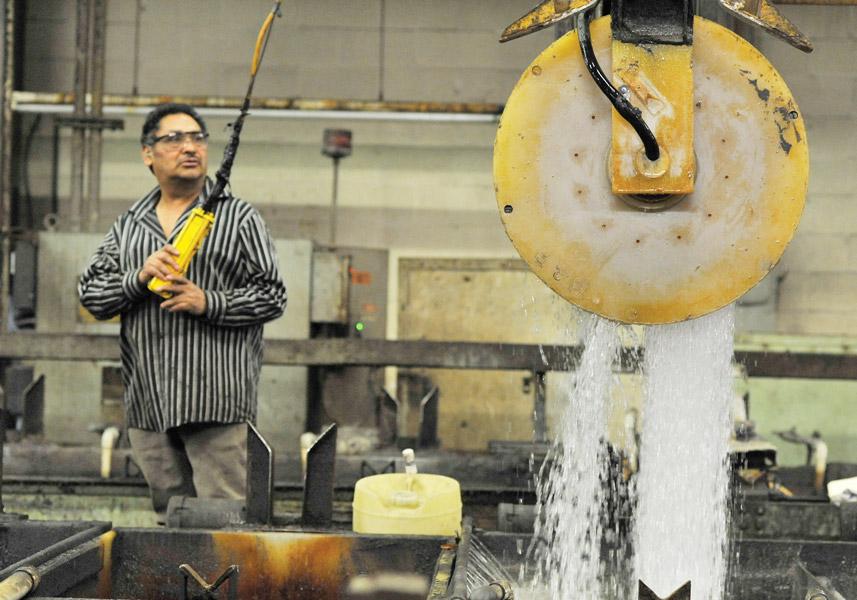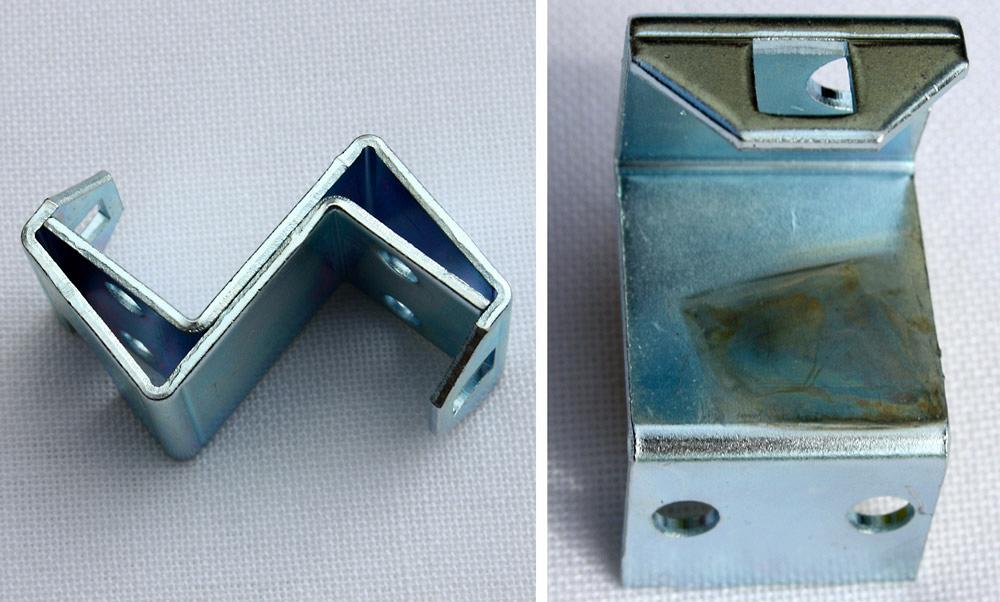President
- FMA
- The Fabricator
- FABTECH
- Canadian Metalworking
Categories
- Additive Manufacturing
- Aluminum Welding
- Arc Welding
- Assembly and Joining
- Automation and Robotics
- Bending and Forming
- Consumables
- Cutting and Weld Prep
- Electric Vehicles
- En Español
- Finishing
- Hydroforming
- Laser Cutting
- Laser Welding
- Machining
- Manufacturing Software
- Materials Handling
- Metals/Materials
- Oxyfuel Cutting
- Plasma Cutting
- Power Tools
- Punching and Other Holemaking
- Roll Forming
- Safety
- Sawing
- Shearing
- Shop Management
- Testing and Measuring
- Tube and Pipe Fabrication
- Tube and Pipe Production
- Waterjet Cutting
Industry Directory
Webcasts
Podcasts
FAB 40
Advertise
Subscribe
Account Login
Search
How to work with your industrial plating provider
Fabricate, communicate, and plate
- By George Gatto, Jr.
- August 10, 2015
- Article
- Metals/Materials
Plating is a critical part of fabrication across a range of industries. Regardless of the type of plating or the reason for it, be sure to keep a few important things in mind when working with a plating provider. A lot of issues discussed here may seem self-evident, but you would be surprised how many manufacturers fail to consider potential problems.
Plating Basics
The plating process involves the depositing and bonding of one metal to the surface of another. An electrical charge causes the ions of the coating metal to become attracted to the ions of the component being plated. This ensures a relatively even, complete coating. Plating companies apply various coating chemistries in a variety of ways, but the two most common for economical corrosion protection are zinc plating and zinc-nickel-alloy plating.
Zinc electroplating improves the corrosion resistance of ferrous metal parts and increases their life. This makes zinc-plated components ideal for both indoor and mild outdoor uses, as the coating protects against the elements. For harsher conditions, or when longer protection is required, a zinc-nickel alloy is used instead. Zinc and zinc-nickel-alloy plating is also used as an undercoat on components that are then given a paint or powder finish.
Barrel Versus Rack Plating
Those are the basics, but there are of course a variety of plating method options—too many to cover in a single article—so we’ll focus on two of the more common methods: bulk/barrel plating and rack plating.
Barrel plating consists of (not surprisingly) a barrel, a tank, the components to be plated, a solution of electrolytic salts (plating bath), electrodes, and a power source to supply the electric current that delivers the coating (see Figures 1 and 2). First the barrel is lowered into the plating bath. Then a positive charge is run through the barrel and the components within, while a negative charge is applied to the plating material in the solution.
The positive current causes the plating material’s atoms to ionize and migrate through the solution to the negatively charged surface of the components, forming the desired coating. The barrel rotates on a spindle, tumbling the components so that the coating is applied evenly. The process can be cost-effective for large batches of small components, fasteners, and small stampings.
One drawback is that as the components tumble and collide in the barrel, certain shapes can become jammed together or fragile parts can be damaged (see Figure 3). Some components may be too large or oddly shaped to fit into a barrel. Not only that, intricate components may fail to receive an even coating when tumbling in a barrel, and this can leave certain areas more susceptible to corrosion or damage.
For components too large, complex, or fragile for barrel plating, rack plating functions much the same way as barrel plating, except the barrel is replaced by a rack (see Figures 4-6). Components are secured on the rack by hooks, spring contacts, or other means. The rack is lowered into the tank, and the plating material and components are charged negatively while the counter-electrode is charged positively. Just as in barrel plating, the difference in charges causes the plating metal ions to migrate and bond with the component surfaces. As the components are suspended on the rack, the coating remains fairly evenly distributed.
Component Size
Now that we’ve addressed the basics, it’s probably obvious what the most important factor in any plating project is going to be: Component shape and size will determine the plating method used, the questions you need to ask your plater as the project moves forward, and the elements that need to be inspected in the finished component.
A large component may need to be broken down into smaller parts, depending on the size of the plating tanks your plater has, though these tanks can be quite large. One of the largest in North America measures 4 feet wide, 7.5 ft. deep, and 27 ft. long.

Figure 1
A barrel descends into the plating bath, which consists of a solution of electrolytic salts.
Also consider how small your components are. Small, flat, light pieces can stick together during barrel plating, which creates voids. This can lead to a lot of wasted time and effort sorting and reworking. In this case, rack plating may be the better choice.
Shape and Surface Considerations
Intricate shapes can be plated, but they may require extra care and inspection. If you have a component that has any of the following attributes, be sure to bring it up with your plater so you can avoid the headache that comes with a poor plating job.
Components that interlock or hook together (U-shaped parts, for example) should be rack-plated, not barrel-plated. Rack plating may be slightly more expensive upfront, but you’ll save time and resources that would be lost to rework or separating the components after barrel plating.
Plating deposits may not reach recesses in certain components easily, so these will require extra attention to ensure those recesses are plated with a sufficient thickness of material. Similarly, components with small inside diameters may fail to be plated, or may cause air pockets that prevent the plating solution from reaching the entire inside surface.
Standard electroplating methods will not deposit coating on the ID of tubing, but if you are careful and ensure it is free of rust before plating, you can use a sealer or rust preventive to protect the tube after plating. It is also possible that a different plating technique can work, or at least have a higher success rate.
Similar to components with deep recesses, parts with tight seams can trap the plating solution (see Figure 7). Prolonged exposure to this solution without any sort of electric current can cause the coating to stain and even degrade over time.
You can address this problem during the part design stage. Talk with your plater about this issue. If you know a component is going to require plating, make sure seams are not so tight that they will trap liquids. Alternatively, you can provide some kind of outlet in the component to allow the plating solution to drain.
When plating a welded component—particularly a tubular one that has been welded shut—some solution can become trapped in the part’s interior. The plating solution will seep out over time and discolor and degrade the coating. To avoid this, make sure welds are tightly sealed or have holes for drainage integrated into the component’s design.
For any welded component, make certain the welded surface is clean, as welding slag, burns, and other defects can cause adhesion problems during plating (see Figure 8). Heavy scale (which can appear on hot-rolled steel as well as welded components) will not plate properly, so it needs to be removed with aggressive cleaning. Platers usually charge extra for heavy-scale removal, assuming they have the capability to do so, so it may be more cost-effective to remove the scale before turning the components over to the plater.
Raw, unmachined surfaces, such as on castings and barstock, can cause problems too. These porous surfaces can absorb or trap the plating chemicals, which again seep out over time and cause the plating to degrade. Extended rinsing after plating usually prevents this, though this does mean that the plating process will take longer than usual, so be aware of that when discussing cost and project timelines with your plater.

Figure 2
A barrel emerges from the plating bath, where a positive current caused the plating material’s atoms to ionize and migrate through the solution to the negatively charged surface of the components to form the desired coating.
Over- and Underplating
The component’s shape and composition influence the way current runs through it. There will be areas of high and low current density, which in turn will create regions of high and low plating thickness. Component corners, edges, protruding bolts, and fastener threads generally are areas of high current density, while the center region of a flat or a deeply recessed surface may be an area with low current density.
Surfaces with low current density may fail to meet your minimum plating thickness requirement. Depending on your maximum thickness limit, this may not be an issue, as you may be able to build a thicker coating to ensure all areas of the part meet your plating thickness requirement.
Talk to Your Plater
A good plater should be able to recommend the method and composition of the plating material that will best suit your needs. Don’t be afraid to ask any potential plater to run some test components. Running tests helps identify potential trouble spots and gives you a good idea of the standard of quality you can expect.
Understand that many platers may simply assume you’ve thought through every aspect of your project before approaching them. Communication is critical. Both you and the plater should know precisely what the scope and intricacies of the project are going to be. This includes discussing your expectations and any potential concerns you have regarding component size, shape, or composition. The plater then can help you identify and address potential pitfalls.
In other words, like everything else in business, it all starts with good communication.
Images courtesy of Gatto Industrial Platers.
About the Author
George Gatto, Jr.
4620 W. Roosevelt Road
Chicago, IL 60644
773-287-0100
Related Companies
subscribe now

The Fabricator is North America's leading magazine for the metal forming and fabricating industry. The magazine delivers the news, technical articles, and case histories that enable fabricators to do their jobs more efficiently. The Fabricator has served the industry since 1970.
start your free subscription- Stay connected from anywhere

Easily access valuable industry resources now with full access to the digital edition of The Fabricator.

Easily access valuable industry resources now with full access to the digital edition of The Welder.

Easily access valuable industry resources now with full access to the digital edition of The Tube and Pipe Journal.
- Podcasting
- Podcast:
- The Fabricator Podcast
- Published:
- 04/16/2024
- Running Time:
- 63:29
In this episode of The Fabricator Podcast, Caleb Chamberlain, co-founder and CEO of OSH Cut, discusses his company’s...
- Industry Events
16th Annual Safety Conference
- April 30 - May 1, 2024
- Elgin,
Pipe and Tube Conference
- May 21 - 22, 2024
- Omaha, NE
World-Class Roll Forming Workshop
- June 5 - 6, 2024
- Louisville, KY
Advanced Laser Application Workshop
- June 25 - 27, 2024
- Novi, MI

































